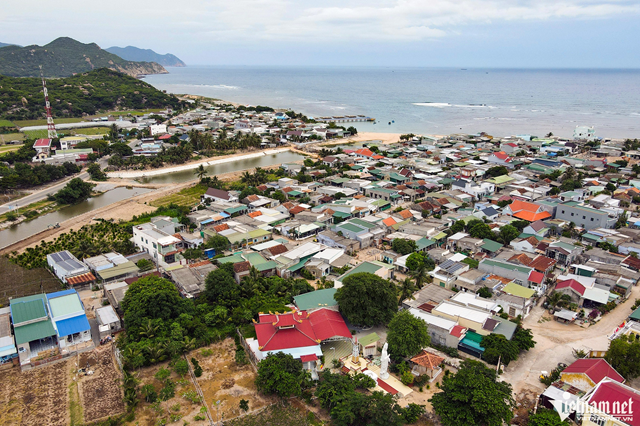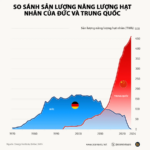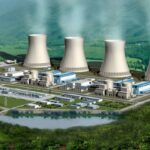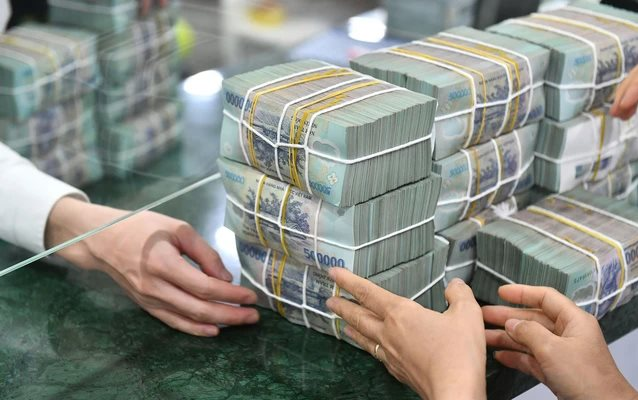Nuclear power is a significant source of baseload power that can provide stable electricity supply. It is a green and sustainable energy source, making it crucial for diversifying energy sources, ensuring energy security, and facilitating the transition to green energy. Achieving net-zero emissions by 2050, as pledged at COP26, is within reach with the development of nuclear power.
On November 30, the National Assembly passed a resolution to continue the policy of investing in the Ninh Thuan nuclear power project. The government has been assigned to allocate resources to restart the project as per the conclusions of the competent authority.
Thus, after an eight-year hiatus, the Ninh Thuan nuclear power project is back on track.
Prior to this, the locations for the Ninh Thuan 1 and 2 nuclear power plants underwent a lengthy and meticulous selection process, meeting stringent international criteria and deemed suitable for constructing nuclear power plants in Vietnam.

One of the two planned locations for the nuclear power plants in Ninh Thuan. Photo: Xuan Ngoc
|
So, which technology should Vietnam opt for in nuclear energy development?
According to a recent report by the Institute of Energy (Ministry of Industry and Trade) on international experience and nuclear power development in Vietnam, the popular nuclear power technology trend globally in the coming time is to build new light-water reactors (LWRs) with advanced third-plus generation technology; research and develop fourth-generation reactors; and research and develop small modular reactors (SMRs).
Most of the recently considered nuclear power plants are second- and third-generation reactors, with all the newly constructed reactors being second-plus generation light-water reactors.
The majority of new nuclear power plants under construction or in operation feature large, improved designs with capacities ranging from 1,000 to 1,700 MW. They are built on proven systems and incorporate technological advancements.
“After the Fukushima nuclear accident in Japan in 2011, there have been numerous demands for improvements in plant safety,” emphasized the Institute of Energy.
Consequently, the approach to safety is informed by statistics, experience, and the ability to analyze and assess accidents using modern computer simulation and forecasting tools, as well as the application of artificial intelligence (AI) in analytical methods. Safety systems have been augmented, combining active and passive safety measures to ensure functionality even in the absence of electrical power supply. Additionally, multiple backup systems are installed in new designs.
Meanwhile, fourth-generation reactor designs are being refined to enhance sustainability by improving nuclear fuel utilization efficiency, reducing nuclear waste emissions, enhancing safety, eliminating the need for accident management, and boosting economic efficiency…
According to the Institute of Energy, for large-scale nuclear power plants, the technology has been proven. Despite past accidents, traditional nuclear power remains a relatively safe technology; it boasts a high energy density relative to the required area; has low carbon emissions; operates at lower costs compared to many other technologies; consumes very little fuel, and does not require large fuel storage facilities.
Notably, electricity production is typically unaffected by weather conditions, making it a baseload power source that meets high electricity demands due to its high efficiency and load factor (80-90%).
However, traditional nuclear power development necessitates the management of investment capital and construction schedules, as these are crucial yet relatively uncertain factors.
Additionally, social acceptance, operational safety, nuclear waste storage and treatment, supply chain participation, human resource development, and nuclear culture are among the issues that require attention during the implementation and operation of traditional nuclear power plants.
Regarding small modular reactor (SMR) nuclear power technology, the advantages include more proactive and flexible investment management, lower site costs, and a wider range of site options due to the smaller area required. Moreover, SMR technology may garner easier social acceptance, and shorter construction times are expected due to simpler designs.
Most SMR designs adhere to a passive safety philosophy, minimizing radiation leaks in most scenarios and eliminating the possibility of severe accidents.
Notably, the distributed nature of SMRs reduces the need for transmission grid reinforcement compared to large-scale nuclear power; they facilitate flexible operation of the power system with a high penetration of renewable energy; and floating SMRs can quickly supplement capacity shortages in load centers.
Floating SMRs are also a viable option due to the mobility of the power plants, allowing them to be relocated if necessary. In this regard, floating nuclear power plants are suitable for coastal areas or places far from the central power system.
From a technological perspective, the Institute of Energy remarked that advanced third-plus generation light-water reactors (LWRs) are proven and widely commercialized, with nearly 70 years of operational experience.
While SMRs offer advantages in construction time and total investment compared to traditional reactors, there are some technological challenges as they are not yet commercialized. Therefore, further research is needed to ensure operational verification.
According to Ha Dang Son, Director of the Center for Energy and Green Growth Research, many people believe that smaller-scale projects are easier to finance and execute. However, in his discussions with nuclear energy experts, he learned that the processes involved in working with international partners are similar for small and large-scale nuclear power plants.
This means that constructing a small-scale nuclear power plant requires the same steps and involvement of the International Atomic Energy Agency (IAEA) as building a plant with ten times the capacity.
Moreover, small-scale nuclear power projects are still in the experimental phase and are not yet fully proven technologies, according to the information shared. Therefore, it would be unwise to gamble with national security by adopting an experimental technology.
“I believe we should opt for large-scale nuclear power projects. Perhaps in the future, in 10 or 20 years, when small-scale nuclear power technologies are fully developed and widely adopted, we can consider implementing them,” he said.
The Institute of Energy suggested organizing the formulation of a nuclear power development plan to clarify the potential for developing large, small, and micro-scale nuclear power plants. This should include identifying potential and feasible locations for nuclear power plants.
In addition to the two sites in Ninh Thuan, the Institute proposed considering replacing old coal-fired power plants that have reached the end of their lifespan with nuclear power plants.
Tam An
The Atomic Age: Nuclear Power by 2031
The Ministry of Industry and Trade has proposed two scenarios for the development of Vietnam’s power sources. In the first scenario, the country could operate its first nuclear power plant as early as 2031, while the second scenario envisions a later launch date of 2035.
Nuclear Reboot: Vietnam Steps into a New Age
In today’s context, restarting the Ninh Thuan nuclear power project is not just a solution to the country’s energy security but also a step towards a green and sustainable economy, propelling Vietnam’s science and technology to new heights. To ensure the project’s success, comprehensive preparations are essential, encompassing technological safety, high-quality human resources development, and societal consensus.




















